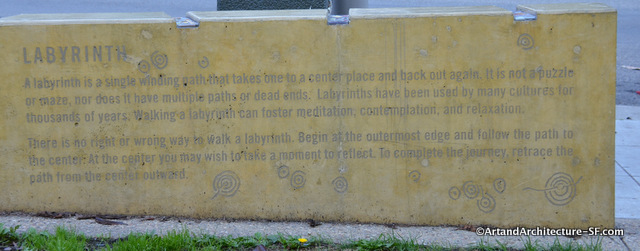Scott Street
Lower Haight
Duboce Triangle
This labyrinth was part of Duboce Parks revitalization plan. The plan, funded by Friends of Duboce Park, began with fundraising in 1997 and took years to accomplish. The labyrinth was laid in 2007.
It was proposed by Friends’ Janet Scheuer, who had walked labyrinths all over the world. “We need to create a quiet spot for people,” she said. She volunteered to “own” the project, find funding and work with designers. Hal Fischer headed up the fund raising. They raised $90,000, with $5000 from San Francisco Beautiful, $25,000 from the CPMC Davies Campus that adjoins the park, and $10,000 from Charlotte Wallace and Alan Murray. Rec and Park contributed around $80,000, says landscape architect Marvin Yee, Capital Improvement Division.
The Scott Street site had been occupied by a play structure in the shape of a pirate ship. Toxic, closed down and rotting away, it was ripe for extreme makeover. Janet recruited designers Richard Feather Anderson, a founder of the Labyrinth Society and Willett Moss, CMG landscape architect to create a labyrinth. The 23 ft. wide multi-circular path was sand-blasted into concrete. A border of mosaic tiles made by members of the community surrounds it, and a commemorative tile collage of the pirate ship graces the concrete bench facing the path. …
The joyous opening celebration April 28, 2007 was short-lived when the labyrinth was closed two days later due to the misapplication of anti-graffiti coating, damaging the labyrinth surface and making it slippery. A reopening eventually took place3 seven months later, on Nov. 2. One of the city’s most unique open space features is now a multi-use area. “People are doing tai-chi, picnicking, reading, walking and meditating,” says Janet happily, adding, “and it all works.”…From the Neighborhoods Park Council.
On this mosaic pedestal sits a labyrinth that allows sight-impaired and other visitors to trace a path with their fingers.
It says in both cursive and braille: With eyes closed, trace the grooved path from the outermost edge to the center with one or more fingers. The center is the halfway point. To complete the journey, retrace the path from the center outward.
This spot where Duboce Park now occupies was originally to be a hospital. However, Colonel Victor Duboce, after serving with the First California Volunteers in the Spanish-American War, returned to the city and was elected to the Board of Supervisors. He died on August 15, 1900 and was buried in the National Cemetery, at the Presidio. Upon his death the city changed Ridley Street to Duboce Street and decided to turn the land into Duboce Park (1900) rather than a hospital The park became a tent city after the 1906 earthquake, sheltering displaced residents from all over the City.




